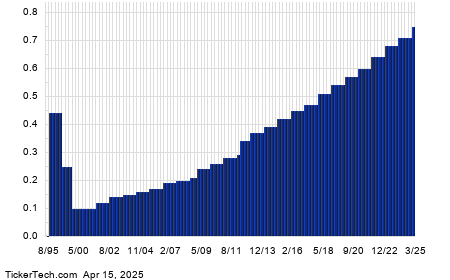Eversource Energy: Enhance Income with Covered Calls Strategy
Shareholders of Eversource Energy (Symbol: ES) may look to increase their earnings beyond the stock’s annualized dividend yield of 5.1%. One way to achieve this is by selling the July covered call at the $60 strike. This move can generate a premium based on the $1.85 bid, which equates to an additional 12.2% annualized return when factoring in the current stock price. This strategy, known as YieldBoost in the options market, results in a total annualized rate of 17.3% if the stock remains uncalled.
However, it’s essential to consider that any price appreciation above $60 means the stock will be called away. For this to happen, ES shares would need to increase by 1.9% from current levels. In this scenario, shareholders would still benefit from a 5% return from their trading level, in addition to dividends earned before the stock is called.
Understanding Dividend Stability Through Historical Analysis
Dividends can fluctuate based on a company’s profitability, making it critical for investors to analyze historical data. The dividend history chart for Eversource Energy below illustrates its past performance, providing context for whether the 5.1% yield is sustainable.

The chart below underscores Eversource’s trading trajectory over the past twelve months, with the $60 strike point clearly marked.

Assessing the Risk-Reward Ratio for Selling Covered Calls
Utilizing the chart and considering the stock’s historical volatility can aid investors in determining whether the $60 covered call presents a rewarding opportunity. Analysis shows that Eversource Energy’s annualized volatility is 24%, calculated based on the last 251 trading day closing values and the current price of $58.72. For further insights and ideas on various call options contracts, you can explore the ES options page on StockOptionsChannel.com.
Market Overview: Call and Put Volume Trends
On Tuesday afternoon, the trading environment for S&P 500 components illustrated a significant preference for calls. The put volume reached 713,693 contracts, while call volume soared to 1.19 million, resulting in a put-to-call ratio of 0.60 for the day. This figure stands below the long-term median ratio of 0.65, indicating that buyers are currently favoring call options within the market.
Stay informed on the latest call and put options discussions among traders by discovering the top options currently being traded.
![]() Top YieldBoost Calls of S.A.F.E. Dividend Stocks »
Top YieldBoost Calls of S.A.F.E. Dividend Stocks »
Also see:
- TETE YTD Return
- SFK Videos
- EQM Historical Stock Prices
The views and opinions expressed herein are solely those of the author and do not necessarily reflect those of Nasdaq, Inc.

